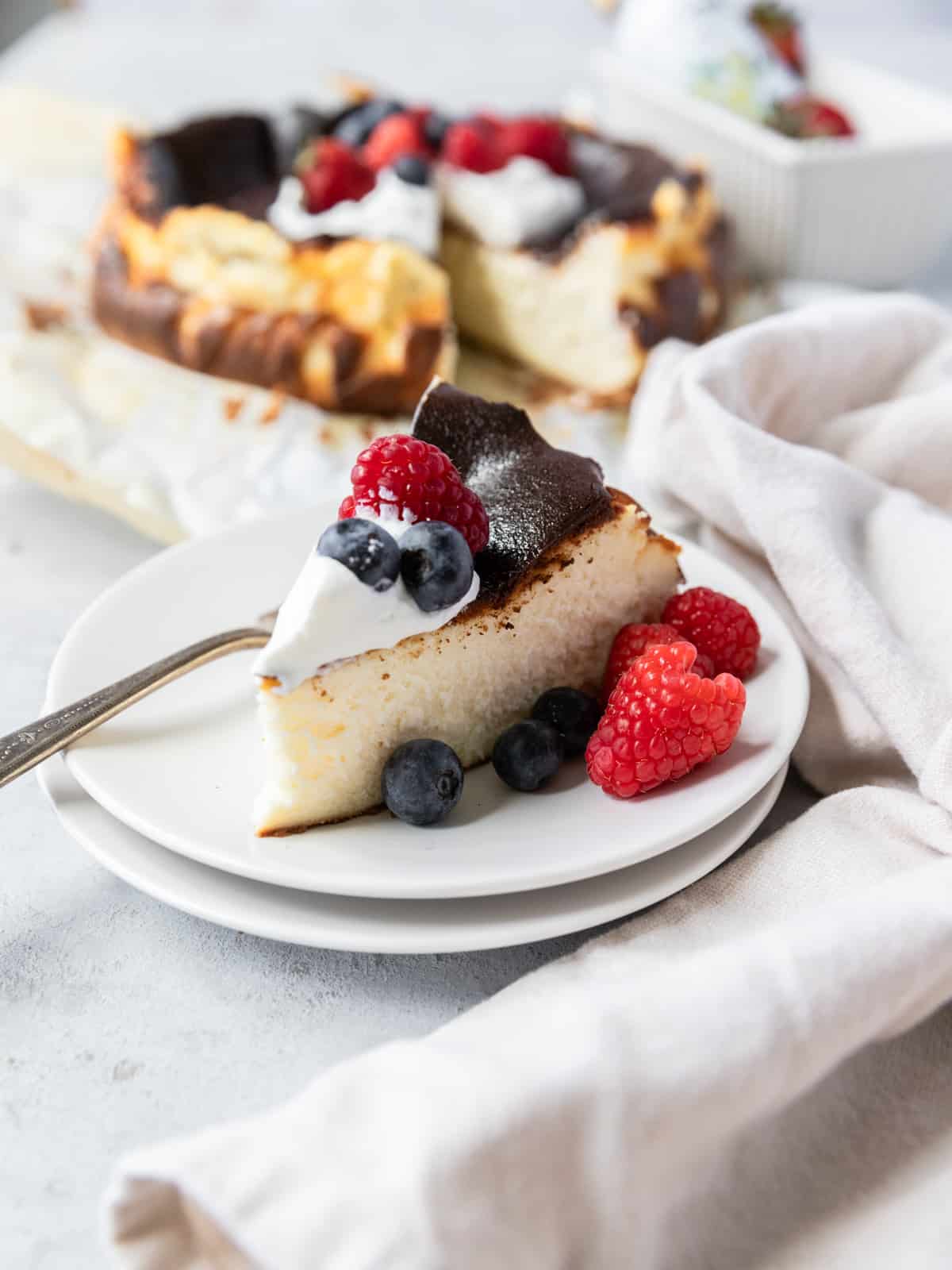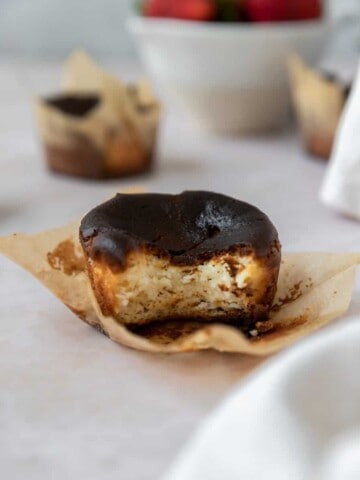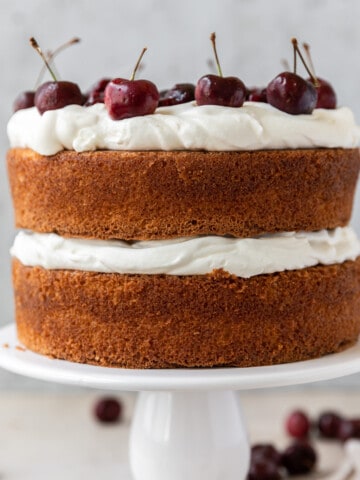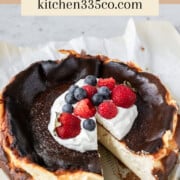San Sebastian Cheesecake is a crustless cheesecake that is baked at a higher temperature for a beautifully burnt exterior and ultra creamy interior. The burnt edges add an incredible depth of flavor to this cheesecake.

The only downside I can find to cheesecake is the time it takes to make. They have to be baked low and slow in order to keep the outside a light color and to avoid cracks on top. Enter: San Sebastian Cheesecake!
It is baked at a higher temperature for a shorter time. The result is a cheesecake that is burnt around the edges. It is basically everything that we've been told cheesecake shouldn't be. But this cheesecake is still smooth, creamy, and rich with an added depth of flavor from the toasty edges. Check out my White Chocolate Cheesecake if you're looking for a more traditional cheesecake!
If you're looking for more cheesecake recipes check out this Sopapilla Cheesecake Skillet Cookie, Mini Lemon Cheesecakes, or Chocolate Covered Strawberry Cheesecake Bars.
Jump to:
Why You'll Love This Recipe
- This cheesecake has a velvety and creamy texture that pairs perfectly with the caramelized exterior.
- It is such a beautifully presented cheesecake that there is no decoration needed! You get the same effect from my Roasted Strawberry Cheesecake Bars.
- It is a unique dessert and a fun departure from your normal cheesecake. Cheesecake Swirled Brownies are another fun twist on cheesecake!
Ingredients

- The cream cheese needs to be at room temperature to prevent lumps in your cheesecake.
- It will be easier to incorporate the eggs into the batter if they are at room temperature.
- Heavy Cream. Heavy cream will help make the cheesecake extra creamy and should also be at room temperature.
- Vanilla Extract. Vanilla is a must in baked goods just like salt. Real vanilla adds a better flavor than imitation vanilla. These Mini Creme Brûlée Cheesecakes also feature a tasty vanilla base.
See the recipe card below for a full list of ingredients and measurements.
Substitutions and Variations
- You can make the San Sebastian Cheesecake in cupcake tins for Mini Burnt Cheesecakes.
- It can be served with whipped cream and berries for added flavor and texture.
- Cocoa powder or chocolate chips can be mixed into the batter for a chocolate version of this cheesecake!
This recipe has not been tested with other substitutions or variations. If you replace or add any ingredients, please let us know how it turned out in the comments below!
Step-By-Step Instructions
STEP 1: Place a rack in the middle of your oven and preheat the oven to 400 degrees (F). Prepare a 10-inch springform pan by rubbing with room temperature butter or spraying with non-stick spray. Then line the pan with parchment paper, be sure to leave excess on the top. Place the pan on a rimmed baking sheet and set it aside.

STEP 2: In the bowl of a stand mixer or in a large bowl with a hand mixer beat the cream cheese and sugar on medium-low speed, scraping down the sides as needed, until the mixture is smooth.

STEP 3: Increase the speed to medium and add the eggs one at a time. Mix until each egg is fully incorporated and scrape down the sides before adding the next. Add the cream, salt, and vanilla and beat until combined. Scrape down the sides of the bowl.

STEP 5: Sprinkle the flour evenly over the mixture and beat until just combined. Scrape down the sides of the bowl and beat again until the mixture is very smooth.

STEP 6: Pour the batter into the prepared pan and bake for 60-65 minutes. The cheesecake should be deeply browned and the center should still be very jiggly.
STEP 7: Remove the San Sebastian Cheesecake from the oven and allow it to cool. The cheesecake will fall drastically during this time. Remove the cheesecake from the mold and cool completely in the fridge.
STEP 8: Peel the parchment paper away and cut the cheesecake into slices to serve.
Expert Baking Tips
- Beat at a low speed. Beating your cheesecake filling at a low speed will prevent air bubbles from forming. It takes a bit longer, but it is worth it in the end.
- Make sure your ingredients are at room temperature. If all of your ingredients are at room temperature they will combine a lot easier and it will prevent lumps from forming.
- Scrape down the bowl. I scrape down the bowl often while making the cheesecake filling. This ensures that everything is getting well combined.
- Don’t over-bake. A lot of times we think cheesecake isn’t done baking because it is still jiggly, but this is when we want to stop the baking process. If you let the cheesecake cool in the oven and then in the fridge they will set up and be a perfect consistency.
Recipe FAQs
A regular cheesecake is pale in color and creamy throughout while a San Sebastian Cheesecake is darker in color, set on the edges, and creamy in the center. Although this dessert originates in Spain it is becoming increasingly popular in Istanbul, Turkey!
They are the same thing! Some people call it basque and some call it San Sebastian, but they are talking about the same cheesecake.
The ingredients weren't at room temperature when you mixed the batter. It won't affect the taste of the cheesecake, but the texture will be off.
Absolutely! Just store in the cheesecake in the fridge until you are ready to serve.
Room Temperature: The cheesecake shouldn't be held at room temperature for too long because it is cream cheese based. I wouldn't recommend longer than a few hours.
Refrigerator: If stored correctly in an airtight container the San Sebastian Cheesecake will last up to 1 week in the fridge.
Freezer: If stored correctly in an airtight container it will last up to 2 months in the freezer.

More Recipes You'll Love
If you tried this San Sebastian Cheesecake or any other recipe on my website, please leave a star rating and let me know how it went in the comments below. I so appreciate hearing from you!
Recipe

San Sebastian Cheesecake
Ingredients
For Cheesecake:
- 4 blocks (908 grams) cream cheese room temperature
- 1 ½ cups (297 grams) granulated sugar
- 5 large eggs
- 2 cups heavy cream
- 1 teaspoon salt
- 1 tablespoon vanilla extract
- ⅓ cup (40 grams) all-purpose flour
Instructions
For San Sebastian Cheesecake:
- Place a rack in the middle of your oven and preheat to 400 degrees (F). Prepare a 10-inch springform pan by rubbing with butter or spraying with non-stick spray. Then line the pan with parchment paper, be sure to leave excess on the top. Place the pan on a rimmed baking sheet and set aside.
- In the bowl of a stand mixer beat the room temperature cream cheese and sugar on medium-low speed, scraping down the sides as needed, until the mixture is very smooth, about 2 minutes.
- Increase the speed to medium and add the eggs one at a time.
- Add the cream, salt, and vanilla and beat until combined. Scrape down the sides of the bowl.
- Sprinkle the flour evenly over the mixture and beat until just combined. Scrape down the sides of the bowl and beat again until the mixture is very smooth.
- Pour the batter into the prepared pan and bake for 60-65 minutes. The cheesecake should be deeply browned and very jiggly in the center.
- Remove the cheesecake from the oven and allow to cool slightly. It will fall drastically. Remove the cheesecake from the pan and allow it to cool completely in the fridge.
- Peel the parchment paper away and cut into slices to serve.
Notes
- Beat at a low speed. Beating your cheesecake filling at a low speed will prevent air bubbles from forming. It takes a bit longer, but it is worth it in the end.
- Make sure your ingredients are at room temperature. If all of your ingredients are at room temperature they will combine a lot easier and it will prevent lumps from forming.
- Scrape down the bowl. I scrape down the bowl often while making the cheesecake filling. This ensures that everything is getting well combined.
- Don’t over-bake. A lot of times we think cheesecake isn’t done baking because it is still jiggly, but this is when we want to stop the baking process. If you let the cheesecake cool in the oven and then in the fridge they will set up and be a perfect consistency.
- The provided nutrition information is an estimate. The calorie accuracy is not guaranteed.












Leave a Reply